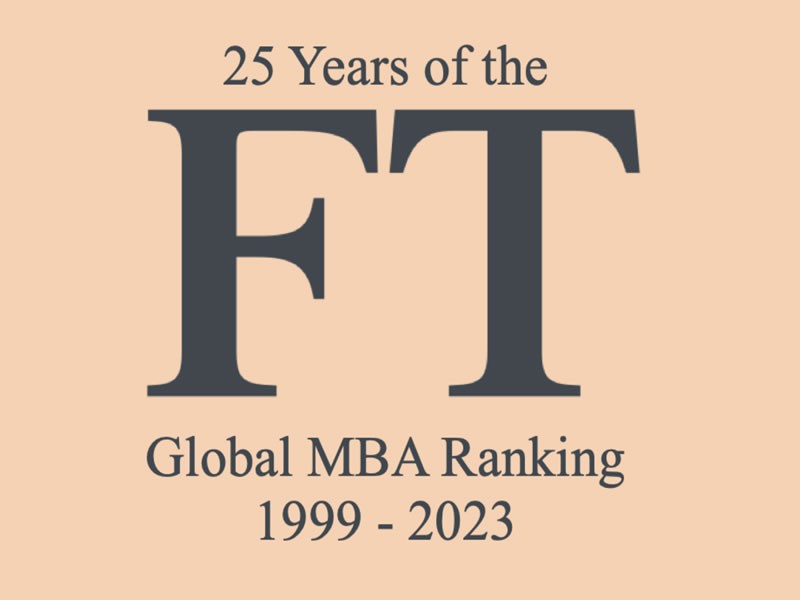Insight Blog
Agility’s perspectives on transforming the employee's experience throughout remote transformation using connected enterprise tools.
11 minutes reading time
(2227 words)
Unlocking the Power of MBA Rankings: How to Use MBA Rankings Effectively
In this article, we aim to delve deeper than mere rankings and dissect their true implications for your future endeavors.
When considering pursuing an MBA, many turn to rankings as a guide for choosing a business school. But do these rankings truly reflect a program's value and guarantee success?
In this article, we'll go beyond rankings to explore their significance for your future. By understanding their context and considering key factors, you'll be better equipped to make informed decisions about your education and career.
MBA rankings serve as valuable tools, offering insights into top business schools worldwide.
MBA rankings serve as valuable tools, offering insights into top business schools worldwide.
and admissions representatives to gain firsthand insights into the student experience and post-graduation outcomes.
Leading rankings such as the Financial Times (FT) and US News MBA rankings provide lists of institutions known for academic excellence, faculty quality, and post-graduation prospects.
However, beneath the surface of these rankings lies a diverse landscape of MBA programs with unique attributes.
We'll delve into the history of business school rankings, assess their limitations, and speculate on their future evolution. Join us as we unravel the complexities behind MBA rankings and empower you to navigate your MBA journey with confidence.
History of business school rankings
The history of business school rankings dates back several decades and reflects the evolution of business education and the increasing demand for accountability and transparency in higher education.
One of the earliest attempts to rank business schools can be traced back to the 1960s when publications like BusinessWeek and Forbes began publishing lists of top MBA programs based on criteria such as faculty qualifications, curriculum, and job placement rates. However, these early rankings lacked consistency and were often criticized for their subjective methodologies.
In the 1980s, U.S. News & World Report entered the scene with its annual ranking of MBA programs, introducing a more systematic approach to evaluating business schools. U.S. News relied on surveys of business school deans and recruiters to assess program quality, adding a level of objectivity to the rankings.
The 1990s saw the emergence of other influential rankings, including those by the Financial Times and The Economist. These publications introduced new criteria for evaluating business schools, such as international diversity, research output, and alumni satisfaction. The proliferation of rankings during this period intensified competition among business schools and fueled efforts to improve program quality and reputation.
In the 21st century, business school rankings have become increasingly sophisticated, incorporating a wide range of quantitative and qualitative metrics to assess program excellence. Rankings now consider factors such as faculty research productivity, student selectivity, alumni earnings, and social impact initiatives. Additionally, advancements in data collection and analysis have enabled rankings to provide more detailed insights into the strengths and weaknesses of individual programs.
Despite their popularity, business school rankings continue to face criticism for their methodology, lack of transparency, and potential to influence institutional behavior. Critics argue that rankings may incentivize schools to prioritize metrics that boost their rankings rather than focusing on educational quality and innovation.
In recent years, efforts have been made to address some of these criticisms by introducing alternative ranking models, such as the 360° MBA Ranking, which considers a broader range of factors, including cultural fit and student satisfaction.
Overall, the history of business school rankings reflects the ongoing quest for excellence and accountability in business education, while also highlighting the challenges and complexities inherent in evaluating the quality of MBA programs.
Understanding the Landscape of MBA Rankings
Navigating the landscape of MBA rankings can be both enlightening and daunting for prospective business school students. These rankings serve as compasses, guiding individuals toward institutions renowned for their academic excellence, faculty expertise, and career opportunities. However, it's essential to recognize that rankings represent just one facet of the multifaceted world of MBA programs. They provide a snapshot based on specific criteria, often overlooking crucial aspects such as program fit, culture, and personal aspirations.
Despite their limitations, MBA rankings offer valuable insights into the global business education ecosystem.
Publications like the Financial Times (FT) and US News compile comprehensive lists, allowing candidates to compare and contrast schools based on various metrics. These rankings foster healthy competition among institutions, encouraging continuous improvement and innovation within MBA programs.
Yet, it's vital for aspiring students to approach rankings with a critical eye, recognizing that they represent a simplified view of complex educational offerings.
The proliferation of MBA rankings has sparked discussions about their methodology and relevance. Critics argue that rankings may prioritize metrics that don't necessarily align with students' needs or accurately reflect a program's quality. As a result, some business schools have opted out of participating in rankings altogether, focusing instead on enhancing their unique strengths and fostering a supportive learning environment.
This shift highlights the importance of looking beyond rankings and conducting thorough research to find a program that resonates with individual goals and values.
So understanding the landscape of MBA rankings requires a balanced approach.
While rankings provide valuable benchmarks for evaluating business schools, they should be viewed as just one tool in the decision-making process.
Prospective students should supplement rankings with in-depth research, campus visits, conversations with alumni, and personal introspection to find the best fit for their educational and career aspirations.
By doing so, individuals can navigate the complexities of the MBA landscape with clarity and confidence.
How the Financial Times Creates Their Global MBA Rankings
The methodology employed by The Financial Times in gathering its data can be broken down as follows:
While this breakdown may suggest a reliance on qualitative data, the reality is more nuanced. The student survey component, constituting a significant portion, includes inquiries about pre- and post-MBA salaries. Only a minor fraction (7% of the total ranking) comprises qualitative aspects.
- Student Survey/Alumni Responses: 56%
- School Data: 34%
- Research: 10%
While this breakdown may suggest a reliance on qualitative data, the reality is more nuanced. The student survey component, constituting a significant portion, includes inquiries about pre- and post-MBA salaries. Only a minor fraction (7% of the total ranking) comprises qualitative aspects.
These qualitative elements encompass two key questions:
1. Whether alumni have achieved their stated goals or reasons for pursuing an MBA.
2. The effectiveness of the school's career services, rated by alumni based on career counseling, personal development, networking events, internship search, and recruitment support.
Graduates fill out the student survey three years post-MBA, with responses from 2024, 2023, and 2022 contributing to the latest ranking. The school data segment evaluates metrics such as gender equality, international diversity, and the proportion of faculty holding doctoral degrees.
The Research category, exclusive to The Financial Times ranking, assesses faculty-staff publications in 50 selected academic and practitioner journals.
1. Whether alumni have achieved their stated goals or reasons for pursuing an MBA.
2. The effectiveness of the school's career services, rated by alumni based on career counseling, personal development, networking events, internship search, and recruitment support.
Graduates fill out the student survey three years post-MBA, with responses from 2024, 2023, and 2022 contributing to the latest ranking. The school data segment evaluates metrics such as gender equality, international diversity, and the proportion of faculty holding doctoral degrees.
The Research category, exclusive to The Financial Times ranking, assesses faculty-staff publications in 50 selected academic and practitioner journals.
The evaluation accounts for publication volume adjusted for faculty size, without considering the quality or significance of the publications.
What Does the Latest FT Ranking Show?
The latest Financial Times (FT) ranking offers a comprehensive overview of the top business schools worldwide and their performance across various criteria.
Released annually, this influential ranking provides valuable insights into the evolving landscape of business education. In the most recent edition, the FT ranking highlights trends such as the rise of Asian business schools, the increasing importance of diversity and inclusion initiatives, and the impact of the COVID-19 pandemic on MBA programs.
One notable trend revealed by the latest FT ranking is the growing prominence of Asian business schools. Institutions from countries like China, Singapore, and India have made significant strides in the rankings, reflecting the region's burgeoning influence in the global business community.
This shift underscores the increasing competitiveness and quality of MBA programs in Asia, offering students a broader array of options for their business education.
Also, diversity and inclusion have emerged as key factors shaping the rankings. Business schools that prioritize initiatives to promote gender equality, support underrepresented minorities, and foster an inclusive learning environment have gained recognition in the latest FT ranking. As organizations worldwide prioritize diversity in their leadership ranks, business schools are responding by integrating diversity and inclusion efforts into their curricula and campus culture.
The COVID-19 pandemic has had a profound impact on MBA programs and is reflected in the latest FT ranking.
Schools that successfully adapted to remote learning, provided robust support systems for students, and maintained strong connections with corporate partners have fared well in the rankings. The pandemic has accelerated digital transformation in business education, prompting schools to innovate and rethink traditional teaching methods.
Overall, the latest FT ranking provides valuable insights into the current state of business education and highlights the dynamic forces shaping the industry. As aspiring MBA candidates navigate their options, they can leverage the insights from the FT ranking to make informed decisions about their educational journey and future career aspirations.
How to Use MBA Rankings Effectively
Effectively utilizing MBA rankings involves more than simply selecting the top-ranked program.
Here are some tips on how to leverage MBA rankings effectively:
- Understand the Methodology: Each ranking system employs its own set of criteria and methodology. Take the time to understand how rankings are determined, including factors such as employment outcomes, alumni satisfaction, faculty credentials, and program diversity. This understanding will help you interpret the rankings more accurately and identify programs that align with your priorities.
- Consider Your Goals and Preferences: Reflect on your personal and professional goals, as well as your learning preferences. Consider factors such as program format (full-time, part-time, online), location, industry specialization, and culture. Look beyond the overall rankings to find programs that offer strengths in areas that are important to you.
- Explore Rankings Across Different Publications: While rankings from reputable sources like the Financial Times, US News, and Bloomberg Businessweek provide valuable insights, it's essential to explore rankings from multiple sources. Different publications may prioritize different criteria, resulting in variations in rankings. By comparing rankings across publications, you can gain a more comprehensive view of the top MBA programs.
- Dig Deeper: Look beyond the rankings to gather additional information about MBA programs. Research program curriculum, faculty profiles, student demographics, alumni networks, and career services. Reach out to current students, alumni, and admissions staff for firsthand perspectives on the student journey and post-graduation prospects. Moreover, take a closer look at graduation invitation templates to grasp the ceremonial nuances and community ethos of each program. This comprehensive approach ensures a deeper understanding of academic quality, networking potential, and cultural fit.
- Visit Campuses and Attend Information Sessions: Whenever possible, visit campuses and attend information sessions or virtual events hosted by MBA programs. This will allow you to get a feel for the campus culture, interact with faculty and students, and ask questions about the program. Visiting campuses can also help you assess factors such as campus facilities, resources, and student support services.
- Consult with Advisors and Mentors: Seek guidance from mentors, career advisors, and MBA admissions consultants. They can provide valuable advice based on their knowledge of the MBA landscape and your individual circumstances. Discuss your goals, preferences, and concerns with them to gain insights and recommendations tailored to your needs.
- Engaging with experts: Get advice can broaden your understanding of the business landscape beyond what any ranking system reveals.
By approaching MBA rankings as one of many resources in your decision-making process and considering factors beyond just the rankings, you can make a more informed choice about which MBA program is the best fit for you and your future career aspirations.
Follow us and access great exclusive content everyday: Follow us on Google News
Discovering the Right School Atmosphere
One significant drawback of many rankings lies in their failure to consider school culture metrics. Much like corporate environments, each business school possesses its distinct atmosphere, and it's only natural to seek where you'll thrive best.
Undoubtedly, assessing school culture proves challenging due to its reliance on intangible factors like student-professor rapport, campus norms, and communication dynamics. Until recently, major publications neglected to incorporate any measure of school culture into their rankings.
Recognizing this gap, Unimy devised the Cultural Fit Index, drawing upon organizational studies and original quantitative data. This index incorporates insights gleaned from over 5,100 survey responses from 173 global business schools.
Moreover, it forms an integral part of the innovative 360° MBA Ranking. As an MBA applicant, you now have the opportunity to tailor your ranking based not only on conventional criteria such as career prospects and diversity but also by factoring in cultural fit.
In fact, two-thirds of users of the new ranking have prioritized Cultural Fit as a key determinant in their MBA selection process.
You may also like: Best Apps for Employees: UPDATED 2022 – A Complete Guide
Free ebook: How To Get Your Intranet Off The Ground
Wrapping up
Prospective MBA candidates must exercise caution when relying solely on program rankings as the primary criteria for assessing the quality of their education.
While rankings and reputation are important considerations, they should not be the sole determinants of your decision. It's crucial to prioritize finding an MBA program that aligns with your individual objectives and values.
Look for a program that embraces diversity among its faculty, boasts a strong alumni network, offers robust career support services, and provides ample internship opportunities. Additionally, consider the program's track record of post-graduation success over time, its affordability, and thoroughly understand the available financial aid options.
By taking a holistic approach and considering these factors alongside rankings, you can make a more informed decision that sets you on the path to success in your future career endeavors.
Categories
Blog
(2616)
Business Management
(323)
Employee Engagement
(212)
Digital Transformation
(174)
Growth
(119)
Intranets
(115)
Remote Work
(61)
Sales
(48)
Collaboration
(36)
Project management
(29)
Culture
(28)
Customer Experience
(26)
Knowledge Management
(21)
Leadership
(20)
Comparisons
(6)
News
(1)
Ready to learn more? 👍
One platform to optimize, manage and track all of your teams. Your new digital workplace is a click away. 🚀
Free for 14 days, no credit card required.








![What Is an Intranet for Business? [2026 Guide] What Is an Intranet for Business? [2026 Guide]](http://agilityportal.io/images/easyblog_articles/1496/b2ap3_thumbnail_What-Is-an-Intranet-for-Business.png)





